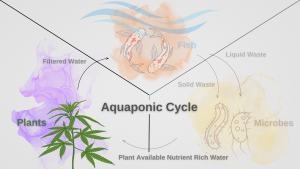
In this month’s blog, we’re moving on from the microbes and into the third wedge of the Aquaponics Cycle: the plants.
Our fish have eaten and released waste, and our microbes have processed that waste into a form that can easily be absorbed by our plants. So how do water and nutrients from our aquaponics system actually get into our plants?
Imagine the lobby of a high-security skyscraper. To get to the elevators and make your way up, everyone needs to pass through one of the available security check points. Some of the check points are wide open channels, visitors with the right credentials can walk right through. For others, they need to walk through a metal detector; one extra step, but not much hassle. The third type of entry requires work; proof of identity needs to be provided, and a transfer protocol needs to be engaged. For example, the guest swaps places with someone already on the other side, or they get an escort to walk them through.
We’ll start at the surface of the roots. You might remember from my previous blog post that nature has a specific recipe for organs that get material into and out of an organism: make a structure with maximum surface area, make it really, really, tiny, and have a ton of them. Roots follow this same recipe: thick primary roots branch into thinner secondary and tertiary roots, which are covered in microscopic root hairs. This maximizes the roots’ surface area and contact with the soil or water it is growing in, allowing for maximum uptake of essential water and nutrients. The root surface is the lobby of our skyscraper.
Water enters the roots through the wide-open channel, osmosis. Water is pulled into the cells of the roots without the plant having to expend any energy for two reasons:
1. Because the concentration of ions inside the cell (past the checkpoint) is greater than outside the cell (i.e. the water concentration is lower inside the cell), this naturally draws water into the cell along the concentration gradient.
2. Because a pressure gradient exists across the cell membrane (i.e., there is lower pressure inside the cell) water is pulled into the cell.
Nutrients enter the roots one of two ways: passive or active transport. Passive transport happens if the concentration of the nutrient is lower on the other side of the check point. They can get pulled through the free channel (diffusion) or through the metal detector (facilitated diffusion). Similarly, if there is a significant ionic gradient, for example, there is a bunch of positive hydrogen ions outside the cell, but not a lot inside, other positive ions (like K+, Ca2+), can diffuse across this “electrical concentration gradient” into the cell.
Active transport is needed when there are higher concentrations of a nutrient or an ion inside the cells of the roots compared to outside because the nutrients are going into the cell are going “against” their concentration gradient. Like swimming against the current in a river, the plant needs to expend energy to absorb them – these nutrients can’t just saunter across the open channel or through the metal detector. The outer walls of the cells of plant roots are equipped with “carriers” for just this reason. Different carriers are shaped to bind specific nutrients, once that nutrient gets bound in the carrier (shows its credentials), the carrier’s cellular machinery pulls it into the cell. Different machinery can do this in different ways, e.g. swapping molecules of similar charge, escorting the molecule across the membrane attached to a carrier molecule, or releasing energy to reshape a protein to pull the molecule across the membrane.
Water and nutrients get absorbed by plant roots through different checkpoints, but those entries lead to the same “elevator” – called the Xylem. The Xylem is a series of tubes which pulls both water and nutrients up the plant roots/stems and into the leaves/flowers/fruit.
In my next blog post, we’ll talk about how the Xylem elevator works.











